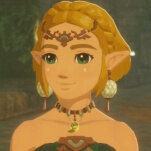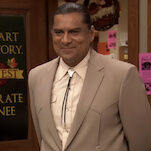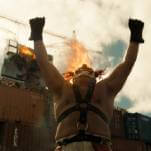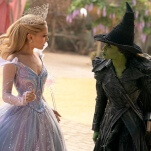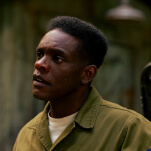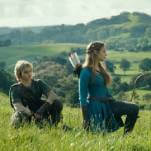Thematically, Acme Novelty Library #20 (Drawn And Quarterly) offers little that readers haven’t seen from Chris Ware before. This is the latest chapter in Ware’s serialized “Rusty Brown” graphic novel, about a sad little kid growing up in Omaha and the sad little people who drift in and out of his life. Acme #20 specifically tells the story of Jordan Wellington Lint, who appeared in Acme #16 and #17 as a cocky high-school stoner who bullies Rusty. Now Ware surveys Lint’s entire life, from birth to death—1958 to 2023—and considers how and why he became such an asshole. All the usual Ware hallmarks are evident: childhood trauma, the loss of a parent, mixed messages about race and morality, an almost crippling preoccupation with sex, an inability to forge lasting relationships, and an old house that keeps calling the protagonist back like a homing signal. But while Ware continues to work in shades of blue (emotionally speaking, that is), he’s become far more daring and varied in his storytelling. The last Acme followed Rusty’s father, a failed science-fiction writer, and included a lengthy story-within-the-story set on Mars; #20 spans 65 years and includes scenes set in churches, recording studios, football stadiums, frat houses, and mini-mansions. Formally, Ware’s work over the past few years—and especially in #20—has been as complex and playful as the early Acme strips and short stories that made him an alt-comics sensation in the mid-’90s. Here, Ware comes up with inventive depictions of how a baby Lint sees the world, how old man Lint feels during a doctor’s appointment, and how one of Lint’s sons writes about his jerk of a father in a bestselling memoir. The fragmented, time-skipping narrative can be hard to follow at times, but it fits together better when reread and when taken as a part of the “Rusty Brown” whole. What separates this work-in-progress from Jimmy Corrigan is that Ware seems to be working more intuitively, inserting rhyming images and structural parallels from chapter to chapter without overemphasizing their meaning. He’s showing how easily a shift in focus creates a shift in perception. In Rusty’s story, Jordan Lint is just a villain. In Jordan’s story, it’s not so simple… A-
Originally published in 1978, Superman Vs. Muhammad Ali (DC) received a deluxe re-release treatment this month. Re-presenting the original material plus 20 pages of sketches, background material, and other bonuses, it’s a well-deserved reconsideration of a worthwhile subject. The art is Neal Adams at his best, with innovative layouts and a spectacular, iconic cover that makes use of his talent for faces by showing a boxing venue filled with ’70s celebrities. The story itself, written by Denny O’Neil in rare form, doesn’t fully deliver on the title premise, but is otherwise largely free of absurdity or contrivance, and even manages to cram in some genuine emotion and a signature O’Neil moral lesson. The original title was a hallmark of ’70s comics, familiar to every comics geek of a certain age, and the only possible complaint about this re-release is that the expanded version’s standard DC Archive page size doesn’t show off the stellar art as well as in the original version, which was roughly the dimensions of an unfolded newspaper. That’s a bit of a quibble, though; in spite of the goofball premise, this is Bronze Age storytelling at its best… A-
For the new issue of Palookaville, Canadian cartoonist Seth abandons the pamphlet format—perhaps permanently—in favor of a hardcover anthology containing the latest installment of his graphic novel Clyde Fans, some samples from his sketchbooks and commercial art jobs, a lengthy photo essay about an elaborate model city he built in his basement, and a melancholy autobiographical strip about a trip to a Calgary book festival. The new format suits Seth; for much of the past decade, he’s been remarkably productive, but the work has been coming out in disconnected pieces, and hasn’t always been easy to find. (With a story as slow-paced and moody as Clyde Fans, waiting sometimes up to a year for another oblique piece of an unfinished puzzle had become less than rewarding.) That said, the material in Palookaville #20 (Drawn And Quarterly) isn’t Seth’s strongest. The Clyde Fans chapter is powerful, detailing the 1975 closing of a machine plant, with Seth using images of the plant’s significance in its community as a kind of Greek chorus in order to explicate the tragedy. But the chapter will undoubtedly be even more resonant when it appears in the finished novel, and the remaining pieces in the book—though engaging enough—feel too much like padding. (And in the case of the “I hate my life” autobiographical story, too much like whining, with little of the self-deprecating wit that Seth is capable of.) Given that Seth has had some real triumphs in recent years with mini-projects like Wimbledon Green, it’s disappointing that he doesn’t deliver a book that’s front-to-back essential. Still, as a first step to a new conception of Palookaville, this 20th volume shows lots of potential… B
The long shadow of Joe Sacco’s masterful Palestine makes it difficult for any cartoonist to tackle Middle Eastern reportage without seeming pale by comparison, but Sarah Glidden’s graphic memoir How To Understand Israel In 60 Days Or Less (Vertigo) gets around The Sacco Problem by approaching the subject honestly, directly, and personally. The book follows Glidden as she travels from Brooklyn to Israel on a “Birthright Tour,” paid for by the global Jewish community. She spends the whole trip bracing herself for Zionist propaganda while trying to get a peek behind the pro-Israel line to see what’s going on with the Palestinians. Glidden draws her story in small, rectangular panels with distinctive, cartoony figures and relatively detailed backgrounds, all washed in delicate pastel colors. The art is lovely, and though the layouts are simple, Glidden works some theatrical effects within those tight frames, flowing back and forth from the words of her tour guides to her own historical research and her conflicted feelings about what she’s hearing. True to its title, How To Understand Israel lays out a fairly comprehensive history of the country and its conflicts, but what gives the book its spark is the way Glidden nests the history in her own prejudices—while understanding that they are prejudices. As the tour progresses, she softens toward the locals, and even feels a connection to Israel that she hadn’t anticipated. She also acknowledges how limiting it is to think of “the situation” in Israel in terms of sides, or to come at it as a tourist. The result is a surprisingly disarming book—easy to read, and rewarding to contemplate… B+
Rather than covering first-issue essentials like introducing characters and setting up a status quo, Generation Hope #1 (Marvel) spins off of the final part of a storyline begun in Uncanny X-Men. Hope writer Kieron Gillen joins Matt Fraction on Uncanny beginning next month, and while this may be an attempt to give the books a tighter connection, it’s bad form for the first issue of a new ongoing title. With the conclusion of the Second Coming crossover, the first new mutants since House Of M have sprouted up across the globe. Having gathered four of “the five lights”—the new mutants’ moniker, which soon becomes a cloying metaphor—mutant messiah Hope Summers and gang travel to Tokyo to recruit their new member: Akira’s Tetsuo. Or rather, a mutant that can make art real and is now Akira’s Tetsuo. It would be clever if the rest of the issue weren’t so disappointing. The clichéd characters range from a wise-talking speedster to a monosyllabic heavy-hitter, and their introductions come via internal monologues that read like a rejected Gen13 script. Salva Espin’s lively, exaggerated pencils are great for facial expressions and action sequences, but his attempts at grittier storytelling get muddled in an inky mess. Both creators’ previous works suggest that all is not lost for Generation Hope, but Gillen and Espin’s first issue is a huge disappointment… C-
After a string of consistently strong Image miniseries and an Action Comics back-up, writer Nick Spencer begins his first major DC title: a relaunch of Wally Wood’s classic T.H.U.N.D.E.R. Agents. T.H.U.N.D.E.R. Agents #1 (DC) reimagines the team in a covert espionage setting, and Spencer teams with artist Cafu to craft one of the best DC launches of the year. Spencer sets up a great concept for the series, giving disgraced people a chance at redemption by granting them powers that will ultimately kill them, and the first issue sets up the series as a place where science fiction, superheroes, and spies will all converge. Spencer constructs the first issue so that small pieces of information are offered gradually and out of context, building suspense by withholding the bigger picture. During the issue’s big action sequence, events happen at a quick pace with little explanation, and the onslaught of information combined with the hectic pacing of three conflicts at once helps emphasize the confusion the characters feel. Cafu’s artwork has a more traditional superhero quality than the story, but his crisp lines and dynamic fight choreography help clarify Spencer’s script. DC wouldn’t push forward with a T.H.U.N.D.E.R. Agents revival if it didn’t have faith in the project (as proven by a bungled relaunch in 2003), and hopefully Spencer and Cafu’s iteration will see a long life… A-
Known for his bleak yet beautiful creator-owned work, Jeff Lemire may not be the obvious choice for writing a new Superboy ongoing series, but Superboy #1 (DC) is a refreshingly upbeat introduction to Conner Kent and his new life in Smallville. After years brooding over his half-Superman/half-Luthor DNA (and dying for a little while), Conner Kent is establishing an identity of his own, and Lemire uses the supporting cast introduced in Geoff Johns’ Adventure Comics to put his own twist on the Silver Age Superboy family. Ma Kent and Krypto are joined by Simon Valentine and Lori Luthor as Conner’s Pete Woods and Lana Lang, and the two characters introduce the teenage drama elements that ground the superheroics. Conner’s romantic feelings for his maybe-half-niece and Simon discovering his best friend’s secret identity are both conflicts with plenty of potential, yet Lemire doesn’t linger on them for too long, instead pacing the issue to cover a lot of ground. There’s a new focus on giving the town of Smallville more definition, and newcomer Pier Gallo fills the city scenes with detail, from storefront displays to people peeking out their window to watch a Superboy/Parasite brawl. Gallo also draws wheat better than anyone else in the business, and Lemire has him do it a lot. The first images of this issue, a boy in a cape standing before an expansive field, recall Lemire’s fantastic Essex County trilogy, and the way Lemire used fantastic elements to examine basic human emotion in those books helps Superboy stand out from the rest of the Super-titles… B+
Superman has always gotten more press, but Captain Marvel may be the greatest expression of comics’ optimism: A young boy says a magical word and turns into the World’s Mightiest Mortal. Chip Kidd and Geoff Spear’s gorgeous new book, Shazam! The Golden Age Of The World’s Mightiest Mortal (Abrams) pays tribute to the hero’s bright colors and medium-spanning stories, all lovingly displayed in Kidd’s signature style. The volume gives glimpses into Marvel’s origins at Fawcett Publications, his time in the film serials, and various character spin-offs like Hoppy the Marvel Bunny. This isn’t a detailed history so much as a cheerful tour through brightly colored nostalgia, with just enough history to satisfyingly provide context for the casual fan. There’s even a complete reprint of an early Marvel story from Jack Kirby and Joe Simon. It’s a coffee-table book that provides a glimpse into a world where the powers of the gods are just an acronym away… A-
Che Guevara: A Manga Biography, the second in Penguin’s series of repackaged Emotional Content primers, takes as its subject the famed T-shirt icon and revolutionary firebrand—a figure just a bit more contentious than the hero of the last entry, Tenzin Gyatso, a.k.a. the 14th Dalai Lama. More complex or not, the Argentine doctor-turned-guerrilla leader gets the same treatment: a slim hagiography that breaks no new ground, but could serve as a good second step—say, as a follow-up to a Wikipedia article—leading toward more in-depth scholarship. Chie Shimano and Kioshi Konno trace Ernesto Guevara’s life from the soul-searching road-trip catalogued in The Motorcycle Diaries to his position of power as Fidel Castro’s No. 2 to his capture and execution at the hands of CIA operatives and Bolivian soldiers. Appropriately, the art is more dynamic and less cartoonish than in Tetsu Saiwai’s Dalai Lama biography, but the localization is still disappointing, with more awkward instances of characters calling each other “Bro.” More off-puttingly, the manga is structured like a highlight reel, with little sense of flow, but the events themselves are engrossing enough, even when Shimano insists on filling every panel with speed lines, apparently in an effort to spin drama out of thin air… C
Canadian cartoonist Scott Chantler’s Two Generals (McClelland & Stewart) is an ambitious attempt, in the tradition of Maus and Persepolis, to blend historical storytelling with personal biography, and while not as successful as some of its antecedents, it’s still an extremely worthy effort. Chantler’s grandfather served in World War II with Canada’s Highland Light Infantry, and through historical anecdotage and first-hand reminiscences, he depicts the process of training, the troops’ fear and anxiety, their fatal unpreparedness for battle, and their ultimate showdown at the second Battle of Buron. Chantler is masterful in these sections, but because of the remove of his sources, he’s less comfortable discussing the friendship between his grandfather and his friend Jack Chrysler. Even though these sections have weaker narratives, they’re well-rendered in Chantler’s simple, clean, thick-lined art style, which conjures up a slightly more cartoonish Seth while possessing its own character. It’s just shy of great, but Chantler is a talent not to be ignored… A-
Hugely popular in its native France (where Luc Besson recently adapted it to film), Jacques Tardi’s Adele Blanc-Sec adventures have never captured an American audience. After years of effort, though, The Extraordinary Adventures Of Adele Blanc-Sec Vol. 1 (Fantagraphics) is finally seeing a U.S. release, and it’s long overdue. Tardi’s heroine, a cynical but daring young novelist in pre-WWI Paris, is here featured in her first two adventures, facing revivified dinosaurs and a demonic cult. The stories are romping adventures that would appeal to a young-adult crowd, but have plenty of edge and playfulness for grown readers; they function both as an evocation and sly satire of classic adventure stories like Tintin. The clever stories, with hidden meaning always skirting around their simplicity, are perfectly complemented by Tardi’s art; readers familiar with one of the greatest names in French comics will need no introduction, but newcomers will be blown away by his mixture of clean lines and rough edges, and his absolute mastery of mood as he delivers some of the finest illustrations of Paris ever crafted… A
The Little Maakies On The Prairie (Fantagraphics) is the sixth in Tony Millionaire’s collections of strips featuring dipsomaniacal suicide-cases Drinky Crow and Uncle Gabby, and there’s nothing much to distinguish this entry from the others, aside from shameless plugs for the one-and-done Drinky Crow Show and Billy Hazelnuts And The Crazy Bird. That’s more or less the point, though. If the cycle of boozing and puking let up, or if the dedicatedly dumb mini-comic “toppers” were blessed with even a few extra IQ points, Maakies wouldn’t be what it is: glorious filth rendered in high style, with frequent nods to E.C. Segar and George Herriman. It’s beautiful, it’s disgusting, it boasts a sentient goiter running amok, and it features a handsome landscape layout courtesy of Chip Kidd. Ultimately, it occupies some hinterland between hyper-repetitive and constantly surprising—not bad for a cartoon that began life scrawled on a barroom napkin… A-
Dreamed up by No Ordinary Family producer Marc Guggenheim, the newly minted Collider Entertainment imprint for Image is intended to provide a thoroughfare between the worlds of comics and TV writing. The proof of concept is Halcyon #1, a team series with a nice sharp hook: What happens when the world doesn’t need superheroes anymore? Perhaps as shortcut, perhaps as commentary, the issue’s freshly superfluous heroes are well-worn archetypes: Transom is The Flash, Sabre is The Punisher, and Zenith is Superman. They’re all brought up short when crime takes a precipitous drop and their assigned supervillain, Oculus—a Dr. Doom type endowed with a supra-dimensional lair and access to his multiversal doubles—looks to be just cooling his heels. Guggenheim, sharing writing duties with Reapers scribe Tara Butters, adds thoughtful touches like Zenith’s concern over the collateral damage she’s causing dismantling a giant robot, and Dave Sharpe’s clever merger of Arabic script and English words during the hunt for bin Laden gives the slow-to-start issue a necessary jolt. Ryan Bodenheim (Red Mass For Mars) draws crisp, boldly outlined figures and dishes out some impressive pyrotechnics, but his backgrounds suffer from a lack of detail, and the flesh on display during an early sex scene feels more than a bit gratuitous. Assuming Halycon’s generic lineup takes on more definition and Guggenheim doesn’t dither when it comes to the action in issue two, this looks to be a promising, smartly self-aware new series… B+
In addition to its comic-book versions of licensed properties like G.I. Joe and Transformers, IDW has added another venerable geek commodity—Dungeons & Dragons—to its roster. Dungeons & Dragons #1 launches a new ongoing series that picks up where IDW’s D&D #0 left off in August—that is, with an underdog band of sword-and-sorcery-wielding adventurers (including the usual suspects: a human, an elf, a dwarf, and a halfling) setting out to find treasure, fight dragons, and defeat a looming, ominous evil. In this case, a fun twist—orphan zombies—livens up the formula, as does a generous injection of lighthearted, unforced humor. Writer John Rogers and artist Andrea Di Vito aren’t reinventing the 12-sided die here, but they manage to balance action, grit, and visual appeal with just enough warmth and character development to keep things from degenerating into a one-dimensional hack-fest. Dungeons & Dragons is the first of many D&D-derived series IDW has planned for the near future, and if this debut is any indication, it might just succeed at hewing true to the beloved RPG while serving up some readily digestible, meat-and-potatoes heroic fantasy. B










